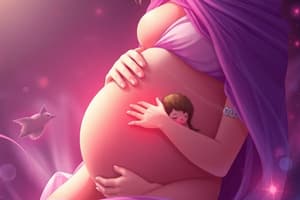Podcast
Questions and Answers
During which period does the puerperium refer to?
During which period does the puerperium refer to?
- The second trimester of pregnancy
- The six week period after delivery (correct)
- The first trimester of pregnancy
- The third trimester of pregnancy
How is uterine involution assessed?
How is uterine involution assessed?
- By counting the number of contractions
- By measuring the fundus by fingerbreadths (FB) (correct)
- By measuring the length of the umbilical cord
- By estimating the weight of the baby
What position should be advised to promote the return of the uterus to its normal position?
What position should be advised to promote the return of the uterus to its normal position?
- Sitting upright
- Standing upright
- Lying flat on the back
- Prone knee-chest position (correct)
When should the fundus be 2 fingerbreadths (FB) below the umbilicus in the postpartum period?
When should the fundus be 2 fingerbreadths (FB) below the umbilicus in the postpartum period?
During which phase of postpartum care does the mother express independence concerning child care?
During which phase of postpartum care does the mother express independence concerning child care?
What could be a reason for overwhelming feelings of sadness in the postpartum period?
What could be a reason for overwhelming feelings of sadness in the postpartum period?
Which factor is NOT necessarily a sign of postpartum infection?
Which factor is NOT necessarily a sign of postpartum infection?
When does the immediate weight loss occur postpartum?
When does the immediate weight loss occur postpartum?
What characterizes the Taking in Phase of postpartum care?
What characterizes the Taking in Phase of postpartum care?
Which of the following is not necessarily a sign of postpartum infection?
Which of the following is not necessarily a sign of postpartum infection?
During which phase of postpartum care does the mother express independence concerning child care?
During which phase of postpartum care does the mother express independence concerning child care?
What characterizes the Taking in Phase of postpartum care?
What characterizes the Taking in Phase of postpartum care?
What could be a reason for overwhelming feelings of sadness in the postpartum period?
What could be a reason for overwhelming feelings of sadness in the postpartum period?
Flashcards
Puerperium duration
Puerperium duration
The six-week period after childbirth.
Uterine involution assessment
Uterine involution assessment
Fundal height is measured in fingerbreadths (FB).
Postpartum uterine return position
Postpartum uterine return position
Prone knee-chest position.
Fundal height (PPD 2)
Fundal height (PPD 2)
Signup and view all the flashcards
Taking-Hold Phase
Taking-Hold Phase
Signup and view all the flashcards
Postpartum sadness reason
Postpartum sadness reason
Signup and view all the flashcards
Postpartum infection sign (not)
Postpartum infection sign (not)
Signup and view all the flashcards
Immediate postpartum weight loss
Immediate postpartum weight loss
Signup and view all the flashcards
Taking-In Phase
Taking-In Phase
Signup and view all the flashcards
Postpartum infection sign (not)
Postpartum infection sign (not)
Signup and view all the flashcards
Taking-Hold Phase
Taking-Hold Phase
Signup and view all the flashcards
Taking-In Phase - behavior
Taking-In Phase - behavior
Signup and view all the flashcards
Postpartum sadness causes
Postpartum sadness causes
Signup and view all the flashcards
Study Notes
Puerperium Period
- The puerperium refers to the period immediately after childbirth, typically lasting around 6 weeks.
Uterine Involution
- Uterine involution is assessed by checking the fundus (the top part of the uterus) and its position in relation to the umbilicus (belly button).
Promoting Uterine Return
- Women should be advised to adopt a position that promotes the return of the uterus to its normal position, such as lying on their side or back.
Fundus Position
- The fundus should be 2 fingerbreadths (FB) below the umbilicus in the postpartum period, ideally within 7-10 days.
Phases of Postpartum Care
- In the Taking-Holding Phase (0-3 days), the mother is often passive and dependent on others for child care.
- In the Letting-Go Phase (3-10 days), the mother expresses independence concerning child care.
Postpartum Blues
- Overwhelming feelings of sadness in the postpartum period can be caused by hormonal changes, fatigue, or emotional adjustments to motherhood.
Signs of Postpartum Infection
- The absence of lochia (vaginal discharge) is NOT necessarily a sign of postpartum infection.
- Fever, tachycardia, and malodorous lochia are potential signs of postpartum infection.
Immediate Weight Loss
- Immediate weight loss occurs postpartum due to the loss of pregnancy-related weight, including the baby, placenta, and amniotic fluid.
Postpartum Care Phases
- The Taking in Phase is characterized by the mother being passive and dependent on others for child care (0-3 days).
- During the Taking-Hold Phase (3-10 days), the mother begins to take on more responsibility for child care.
Studying That Suits You
Use AI to generate personalized quizzes and flashcards to suit your learning preferences.



